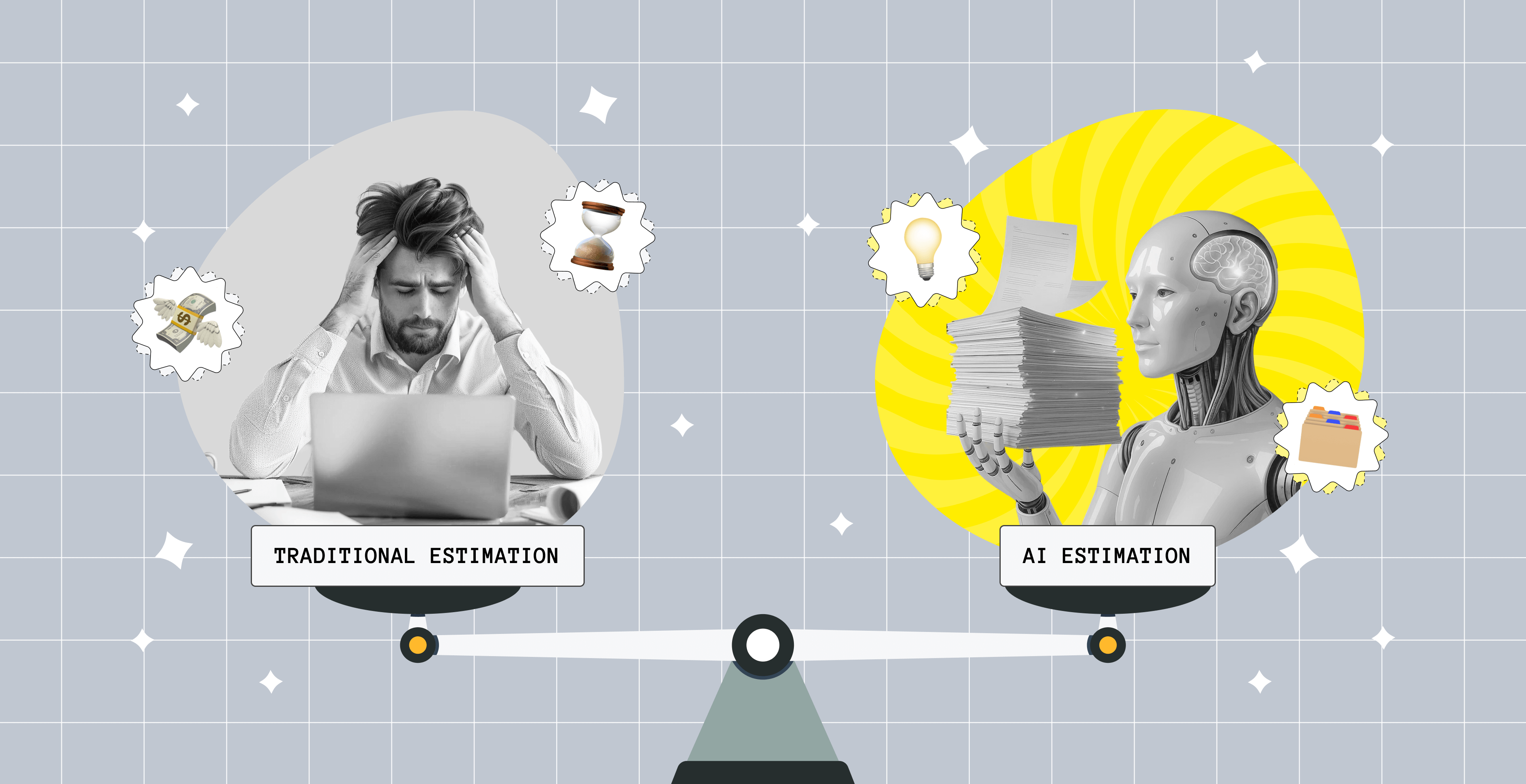Understanding Data Reporting: Types, Benefits and Examples

Companies won't make it far if they don't collect, track, and analyze data. The breadth of gathered information may seem overwhelming: marketing campaigns, sales figures, team efficiency, key performance indicators, various metrics, and statistics. But just like a pinging heartbeat monitor, data reports signal how a business is doing.
In this article, we'll walk you through the must-knows, cover the different types of data reports and their advantages for business, as well as provide data report examples.
What Is Data Reporting?
The main purpose of reporting is to collect data that'll help evaluate, assess, and analyze business performance based on the obtained facts and latest figures.
But what is a data report? It is a presentation of the gathered and merged information from multiple sources. It can serve as an organized and timely record showing the current state or the dynamics of selected criteria over a period of time.

In the old days, such data was handled manually with lots of amendments and calculations done by hand. Obviously, this time-consuming way of how to report data required many resources and often lacked the freshest updates.
Modern reporting tools like Flexter can help with complexity, as well as product analytics platforms like Mixpanel or Amplitude help automate and upscale reporting. This way, data becomes simple to comprehend and digest. By using information that's well-formatted and updated in real-time, a decision-maker can draw conclusions and take action faster (for instance, amend the strategies or effectively make informed calls).
As a rule, data reports may come in various formats. These can be:
- traditional reports (usually with raw numbers and extensive textual resources);
- visualized data (which simplifies perception via graphs, charts, tables, scatter plots, etc.);
- or enhanced solutions (such as intuitive dashboards).
Why Is Reporting Important?
While the necessity for a business to handle data analytics is pretty straightforward, many companies still face several challenges.
One of them is that not all employees are as "analytics-literate" as you'd want them to be. This is because analytics may be hard to grasp if data reporting isn't addressed optimally.
If reports take too long to create or understand, this is another red flag. You'd be surprised how many businesses in the 2020s still rely on good-old static PDFs and Excel spreadsheets which may take forever to scroll through, let alone to figure out. This is exactly why reporting is important for business. To streamline this challenge, consider utilizing marketing report templates that offer pre-made solutions tailored to various digital marketing needs or other specialized tools designed to significantly reduce the time and effort required to create comprehensive and understandable reports. Either way, you have to aim to break down complex data into simpler insights that anyone can grasp.
At this point, you're probably picturing bored faces blankly staring at their screens or dozing off. But this problem may be more significant than you think. According to Towards Data Science, 74% of employees admit feeling unhappy or overwhelmed when working with data, while 14% prefer to avoid such tasks altogether. Topping that, an impressive percentage of employees claim that data analytics tasks cause stress or burnout and result in procrastination.

This is bad news for businesses. But even more so, sloppy or overcomplicated data reports often lead to miscomprehension and missed opportunities since pivotal indicators are left unnoticed.
What if you could have cut down costs on a tactic that isn't returning needed profit? Or what if better online reporting would allow your organization to predict the market changes and get prepared instead of missing out?
The bottom line is that a business will gain more if data analytics reporting stops being a hassle. That's why by using reporting solutions, organizations get a chance to eliminate loads of manual work and reduce human errors.
So, why are reports important? When utilized wisely, data reports become easier to cope with and can serve as an all-encompassing source of priceless information that reflects the current state of the company's core processes. This is why you should take data visualization reports seriously, as they allow for further analysis and lead to improved decision-making.
What Are the Benefits of Data Reporting?
When modern tools and data analytics perform in a duet, tangible value is seen almost immediately. Modern data analysis reports come in different shapes and sizes. And the best part is that they no longer have to be those run-on spreadsheets with pages of explanations that are exhausting to work with. With a proper approach, data reporting may become a fundamental basis for business growth. Below we list some notable advantages of data reporting.

1. The Team Understands the Big Picture
A simple-to-use dashboard that pulls data from reports in real-time keeps more people on track. Great data reporting examples prove that it makes crucial information accessible and defies the boundaries between analytics-savvy specialists and regular users, making complex graphs a thing of the past. As a result, you get a team that's in sync and easily crunching data.
2. Not Missing Critical Insights
Once again, simplicity is the biggest ally of data reports. When you see the updates in real time, it lowers your chances of important business discoveries slipping away from your sight. This includes both positive and negative aspects, such as a sudden drop in conversion or, on the contrary, opportunities to make additional profit. You get control over the data that may have previously been a hassle.
3. Faster and More Informed Decision-Making
It may sound disappointing, but many wrong decisions have led to budget drain specifically because data didn't back the assumptions. And this could have been avoided if a business had taken a step up to collect data properly and emphasized data reporting. Curated data that is organized and well-presented simplifies perception.
Yes, business is very unpredictable, but just as with weather forecasts, you can make more precise calls if you monitor the situation in real time instead of taking wild guesses.
4. Enhanced Budget Distribution and Planning
Resource allocation and determining the business or startup budget flow are not simple tasks. Yet when reporting data, all the information is available at a glance, so you can save money and know which areas need more resources and where you should cut costs.
5. Plenty of Room for Customization
Regardless of the path you take, it's possible to tweak data reports around your needs. Depending on the purpose and requirements, you may craft the reports or dashboards to suit various objectives, enhancing their designs in terms of usability. It makes sense to play around with tools like an online report creator and try to find the optimal data report format for your use case. Flexibility is among the things that make data analysis reports so great.
Need a hand with data reporting?
Don't be shy to reach out, Upsilon's team is always ready to assist with data report optimization.

Major Data Reporting Methods
Now that we know what is a data report, how can you organize data for reporting purposes? For starters, it is worth noting that reports could be static and interactive.
- As you might have guessed, the data in static reports is constant and usually doesn't change.
- Interactive reports let users interact with the data directly (for instance, through filtering, sorting, or extraction) to look at it from different angles and get deeper insights.
- Moreover, auto-updating reports can be distinguished, too. These are the kinds that self-update information without manual involvement, continuously fetching the freshest data.
Let's overview the common approaches and techniques used for communicating or presenting data for analysis. The reports below can be created static or interactive, and the best applicable method will depend on the purpose, objectives, nature of the data, desired level of intricacy, and context, but here are the most often used ones.

Narrative Reporting
Such data reporting generally implies the usage of the verbal, written, or text format. The key findings are wrapped into textual descriptions, explaining the major takeaways, providing context, or interpreting the key findings. This method is sometimes used for market research or to present conclusions or synopses. This type can be combined with storytelling and visualization techniques to better guide the audience.
Tabular Data Reporting
This format implies putting data into a table. Such data analysis reporting is commonly used when there are many numbers like when making calculations, extracting database information, or for financial reports. The data in the tables are organized in rows and columns, making the information structured and providing the chance to look into the details. In most scenarios, people use spreadsheets to create and store them.
Statistical Data Reporting
On a similar note, statistical reports are also quantitative ones. They provide an overview of the statistics and data analysis results, highlighting the key figures in the statistics. Such analytical reporting can focus on trends, tendencies, shifts, variations, or overall numbers during a specific time period. The data presentation format may vary, though, often mixing tables with graphs, text, pie charts, comparisons, and other visuals in a single data analytics report.
Graphical Reports
Visual elements are the major focus of such reports with minimal text. It's most handy if you have a lot of different or complex data that has to be visualized to become more intuitive, accessible, and easy to grasp or to show trends, patterns, and data relationships. This implies such data presentation methods as using bar graphs, stacked bar charts, line charts, dual-axis charts, pie charts, donut charts, bullet graphs, Gantt charts, area charts, scorecards, scatter plots, bubble charts, funnel charts, heatmaps, or any others. There are plenty of data reporting examples with combos of the visualization types mentioned above.
Dashboards
Dashboards also imply the usage of visual means, however, the additional distinguishing feature of these reports is that they are generally interactive, so users can use data reporting solutions to build them, customize the views, and change the display format to cater to their needs. Moreover, they combine several data representation types in one space (e.g., tables, charts, text, graphs, etc.). As a rule, dashboards are automatically updated and are thus all about near-time or real-time data monitoring and analysis, that's why they're valuable for business analysis.
Infographics
Such data reports imply mixing various data formats with an accent on visuals with not too much text as well, yet are usually static. They emphasize visual appeal and may therefore include icons, pictures, photos, illustrations, timelines, roadmaps, or anything along these lines. These reports are frequently converted into PDFs or used for printing or posting. To create such reports, you can use tools like AI infographic generators.
Main Types of Data Reports
Many innovations of the digital age have been recently transforming the approach to business analytics, reporting, and data management. Of course, enhanced data curation upscales these processes, paving the way for important insights and gains.

As briefly mentioned, data reporting may come in a variety of forms. Depending on the purpose and needs of an organization, there could be different types of reporting including:
- Overview reports (provide a general outline of the current state of a certain business sphere);
- SEO reports (such data reports overview of search engine optimization efforts from improving rankings and driving website traffic for boosting conversions and generating leads);
- Key performance indicator reports (show the vital performance metrics that are important for the company to monitor);
- Status reports (summarize the stages or task progress, the implementation of plans and goals, reaching KPIs and OKRs, etc.);
- Customer reports (portray client dynamics from conversions and behavior to trends and needs);
- Sales reports (present the company's sales activities, including information on leads, volumes, etc.);
- Financial reports (demonstrate the company's expenses, budget, revenue, profit, accounting, among other money-related things);
- Research reports (provide market insights or integral data that can be used to enhance business or startup growth strategies).
7 Things to Consider When Reporting Data
A data report in itself isn't a magic wand. And if you want it to serve its purpose, the solution must be feasible and created with due thought. Here are several tips you should note if you don't know how to report data properly and are just approaching the matter.

1. Define the Purpose of the Report
First things first, what are you looking for? Aiming at a detail-oriented report is wise, but squeezing too many things in one place is a common mistake. This is especially the case when a report or dashboard started out as something easy to comprehend but grew to become a complicated mess.
To avoid this, do your best to identify what this report is for, as each of your data reports needs a specific aim. List your main questions, such as "Is this report applicable for determining how we're achieving our set KPI?".
2. Decide on the Metrics
Then, you have to settle on whether the corresponding metrics are relevant. Can they coexist in one dashboard or need to be split? How are you going to evaluate and analyze the incoming data? You get one step closer to a good report by pinning down the major indicators.
Even though there are different types of report usage, you have to ascertain data relevance. If so, you'll get one step closer to a good report by pinning down the major indicators.
3. Check the Data Sources
The same goes for resources, as the inputs need to be clear to obtain accurate results in a data analytics report. Where will the data be gathered from? How will it be merged and blended? Make certain that you're fully aware of where you're getting your information from, how you're collecting it, and that it can be trusted.
4. Organize the Data
Plus, although you may have many data sources collected from multiple platforms and channels, the information needs to be clearly integrated, unified, and organized in one central system. When everything is stored in a single place, is logically structured, and has standardized terms and names used by all teams, you omit blindspots in any given data analytics report. Ensure that data from different sources is consistently integrated and accessible, eliminating gaps and providing a clear, unified view for better decision-making.
5. Who Will Use the Report?
There are many data report examples when reports are put together without keeping the user in mind. For instance, although a marketer and sales specialist may both care about conversion rates, the data that's of interest to each of them may be different. Therefore, make your reports adjustable according to the user (e.g., add filters) or make separate solutions for various roles.
Likewise, mind the accessibility of the information as collaboration is a key to effective reporting and data analysis. Ideally, a user should have access to data from various devices, allowing for round-the-clock availability even via a mobile device.
6. Mind Usability
Your reports must be simple to follow and navigate. So, you need to consider your use of colors, structure, layouts, and element placement. By extracting the essentials, you make data relevance a priority. Adding filters and optimal formats to your data visualization reports can help users modify the parameters and find answers to their questions easier and faster.
7. Check Data Accuracy
You should also prioritize the quality of the displayed information, no matter the chosen types of reporting. You wouldn't want to deal with inaccurate data or that shown with the wrong timing, right? Automation and automated marketing reports are your biggest helpers in this respect. So check twice that your data is correct and readily available, for example, that you:
- are delivering the right information in real-time or for a chosen period (week, month, quarter, etc.);
- have no duplicate entries;
- don't have outdated information;
- are avoiding bad data and other inconsistencies.
Not sure where to start with data reports?
Data reporting can become solid analytics leverage. Feel free to discuss your needs with us!

Data Reporting Examples: Upsilon's Experience
Upsilon has been delivering high-end data visualization services and reporting solutions for quite a while now. So, to provide you with specific data visualization report examples that we've worked on, we'd like to tell you about the fully customizable reports we've created for Collectrium.
The objective was to develop a reporting solution that would allow collectors to easily craft detailed reports containing all the vital information about an art object or collection. The process of making as many reports as you want needed to be simple, fast, and straightforward. At the same time, the data shown in the reports had to provide a structured representation of the art collections in an easy-to-comprehend format.
Flexibility and convenience were among the priorities. So, we built templates, fitted the reports with customizable fields and layouts, and organized the process in simple-to-follow steps. Thanks to the implementation of droplists, filters, and ready-made blocks, filling out the details of every object is effortless.

Furthermore, the data reporting solution is now an integral part of Collectrium's customizable dashboard, which includes neat data visualization for key operations using diagrams, charts, and other means.

Closing Remarks on Data Reports
With the market constantly changing, a business needs to be up-to-date and guided by the latest and most relevant data. Although the incoming information pool may be complex, flexible and modern data analysis reports come to the rescue.
Now that we've found answers to such questions as "what is data reporting" and which benefits it can bring, we know that when approached with due thought, they show the full panorama, allowing businesses to stay afloat and not miss a thing. Reinforced dashboards and advanced data reporting bring agility and scalability to organizations and improve their odds of staying competitive in the long run.
If you need intuitive, accessible, and actionable data reports, don't hesitate to contact us, as Upsilon's team is always glad to provide a consultation!
FAQ
to top












